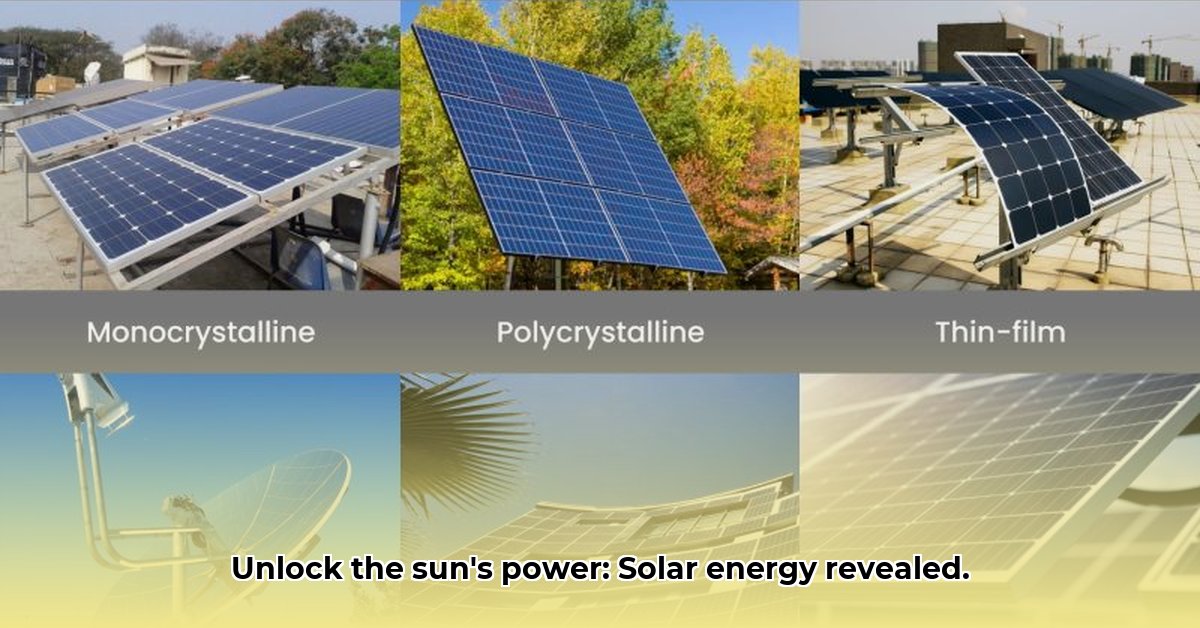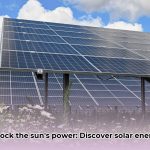Intrigued by solar energy? You’re not alone! Solar power is transforming how we generate and use electricity, offering a clean and sustainable alternative to traditional sources. However, navigating the diverse landscape of solar energy can be overwhelming. This comprehensive guide simplifies the complexities, exploring everything from familiar rooftop solar panels to large-scale solar farms that power entire communities. We’ll delve into the advantages and disadvantages of each solar technology, helping you determine the optimal solution for your specific needs – whether you’re a homeowner, a business owner, or simply an eco-conscious individual. We’ll also cover important aspects such as system selection, performance optimization, and long-term maintenance. For more information on different solar energy types, see [this helpful resource](https://txgenco.com/types-of-solar-energy). Let’s embark on a journey to unlock the immense potential of solar energy!
Exploring the Diverse Landscape of Solar Energy Technologies
Harnessing the sun’s radiant energy is no longer a futuristic concept; it’s a present-day reality. But the realm of solar energy extends far beyond the commonly seen solar panels gracing rooftops. Let’s embark on an exploration of the exciting and varied methods through which we are converting sunlight into usable power, heat, and sustainable solutions.
Photovoltaic (PV) Systems: Converting Sunlight Directly into Electricity
When most individuals envision “solar energy,” the image that typically springs to mind is that of photovoltaic (PV) panels adorning residential and commercial buildings. These systems employ a fascinating process, utilizing specialized materials like silicon to directly transform sunlight into electricity. Think of them as miniature, incredibly efficient solar batteries. PV systems are ubiquitous, ranging from small-scale rooftop installations to expansive solar farms capable of powering entire communities. The remarkable aspect is the continuous advancement in this technology. Scientists and engineers are constantly developing thinner, more efficient panels, and even integrating them seamlessly into building materials – envisioning a future where entire houses function as giant solar panels! Current PV technology achieves sunlight-to-electricity conversion efficiencies typically between 15% and 22%, contingent upon the panel’s design and manufacturing processes. Did you know that photovoltaic technology has advanced to a point where solar farms are now capable of providing electricity to entire towns?
Concentrated Solar Power (CSP): Harnessing Sunlight for Large-Scale Energy Generation
Concentrated solar power (CSP) employs a fundamentally different approach to solar energy generation. Instead of directly converting sunlight to electricity like PV panels, CSP systems use mirrors or lenses – imagine colossal magnifying glasses – to focus a vast area of sunlight onto a single focal point, generating intense heat. This concentrated heat then drives a conventional power plant, typically using steam to spin turbines and generate electricity. CSP is ideally suited for large-scale electricity production, particularly in sun-drenched regions with ample available land. Envision vast arrays of mirrors concentrating sunlight to power an entire city – that’s the potential of CSP! While CSP systems require significant land area, they possess the capability to generate considerably more electricity than PV systems and even store thermal energy for use after sunset, making them a more consistent and reliable power source. Isn’t it remarkable how CSP plants can store heat and continue generating electricity even after the sun has dipped below the horizon?
Solar Thermal Systems: Capturing Solar Heat for Direct Use Applications
Solar thermal systems specialize in capturing the sun’s heat for direct utilization – applications such as heating water and providing space heating for homes and businesses. These systems typically employ flat-plate or evacuated tube collectors that absorb sunlight and transfer the heat to a liquid. This heated liquid then warms water for domestic use or heats air for space heating. Solar thermal systems are particularly effective in regions with abundant sunshine and offer a straightforward, often cost-effective method for reducing reliance on traditional heating fuels such as natural gas or heating oil. They provide a clear and direct pathway to cleaner and more sustainable heating solutions. What are the potential savings on your heating bill if you were to switch to a solar thermal system?
Passive Solar Design: Optimizing Building Orientation for Natural Heating and Cooling
Passive solar design embodies an ingenious approach to harnessing the sun’s energy without relying on complex equipment. It revolves around designing buildings to naturally leverage the sun’s energy for heating and cooling. This involves strategically positioning windows to maximize sunlight exposure during winter months, utilizing high-thermal-mass materials like concrete or stone to store heat during the day and release it at night, and incorporating overhangs or other shading devices to minimize solar heat gain during the summer. Passive solar design is a sustainable, often overlooked strategy that can significantly reduce the demand for conventional heating and cooling systems. This approach emphasizes working in harmony with nature to achieve maximum energy efficiency. Are you aware that passive solar design can substantially decrease heating and cooling expenses?
Hybrid and Smart Solar Systems: Optimizing Efficiency with Integrated Technologies
A noteworthy trend in the solar energy sector is the emergence of hybrid solar systems. These innovative systems cleverly integrate various solar technologies, such as PV panels and solar thermal collectors, to create a customized solution optimized for specific energy requirements. Another crucial element is energy storage, commonly in the form of batteries, which enables the storage of excess energy generated during sunny periods for later use. This directly addresses a significant challenge associated with solar power: its intermittency (it only generates electricity when the sun is shining!). Battery storage and other storage solutions facilitate more consistent energy consumption, making solar a more dependable and reliable energy source. With the advent of hybrid systems and advanced energy storage technologies, solar energy is rapidly becoming an increasingly reliable and consistent energy source.
Choosing Your Solar Solution: A Strategic Approach to Sustainable Energy
Selecting the appropriate solar system is highly dependent on your specific circumstances. Your energy consumption patterns, budget constraints, available space, and local regulations all play critical roles in the decision-making process. Consider the following factors carefully before committing to a particular solar solution:
| Factor | PV Systems | CSP Systems | Solar Thermal Systems | Passive Solar Design |
|---|---|---|---|---|
| Scale | Small to large | Typically very large | Small to medium | Integrated into buildings |
| Primary Use | Electricity | Electricity | Water/space heating | Heating/cooling |
| Typical Cost | Moderate | High initial investment | Moderate to Low | Low initial investment, higher long-term savings |
| Maintenance | Relatively low | Moderate | Relatively low | Minimal |
| Energy Storage | Often integrated | Frequently includes storage | Can be easily combined | Not Directly Applicable |
Experts suggest that a future powered by solar energy will likely involve a combination of these technologies, each playing a distinct role depending on specific needs and environmental conditions. Ongoing research and development efforts are continuously driving innovation in the field, paving the way for even more efficient and cost-effective methods of harnessing solar energy in the years to come. The optimal approach to capturing and utilizing the sun’s energy remains an area of active exploration and discovery. By gaining a thorough understanding of the strengths and weaknesses of each technology and seeking guidance from qualified solar energy professionals, you can make well-informed decisions regarding your ideal solar energy solution. Remember to investigate available local incentives and rebates to further enhance the economic attractiveness of adopting solar energy. The future of solar energy likely lies in a diversified portfolio of technologies, each meticulously tailored to meet specific energy demands and environmental considerations.
Levelized Cost of Energy (LCOE): Comparing Solar Technologies
The solar energy sector is experiencing unprecedented growth, but selecting the right technology can be challenging. One key metric for evaluation is the Levelized Cost of Energy (LCOE). This represents the average cost of generating electricity over the lifetime of a solar system. To compare levelized cost of energy for different solar technologies effectively, it’s essential to understand the underlying principles and influencing factors.
Understanding LCOE: A Key Metric for Evaluating Solar Technologies
LCOE is more than just the initial investment; it encompasses operational expenses, maintenance, financing costs, and the system’s lifespan. A lower LCOE signifies a more cost-effective solution. However, simple comparisons can be misleading, as factors like geographical location (sunshine levels!), financing options, and government incentives significantly impact LCOE. The LCOE considers the entire lifespan of a solar energy system, not just the up-front costs.
Different Solar Technologies: Crystalline Silicon, Thin-Film, and Perovskite
Various solar technologies are vying for market dominance, each with unique strengths and weaknesses affecting LCOE.
- Crystalline Silicon (c-Si): This workhorse of the solar industry boasts mature technology, reliability, and relative affordability. It currently dominates the market.
- Thin-Film Solar Cells: These lightweight, flexible panels often offer lower manufacturing costs, but their efficiency is generally lower than c-Si. Cadmium Telluride (CdTe) and Copper Indium Gallium Selenide (CIGS) are prominent examples.
- Perovskite Solar Cells: This emerging technology demonstrates immense promise due to its potential for high efficiency and low manufacturing costs; however, its long-term stability remains a key challenge.
Calculating and Comparing LCOE: NREL’s LCOE Calculator and Beyond
The National Renewable Energy Laboratory (NREL) provides a valuable tool for calculating and comparing LCOE for different solar technologies: https://www.nrel.gov/pv/lcoe-calculator
However, using this tool effectively requires careful consideration of several factors:
- System Specifications: Input accurate data on panel efficiency, power output, system lifespan, and other
- Hydro Extrusions USA Leads North American Aluminum Profile Solutions - December 28, 2025
- Hydro North America Leads Aluminum Extrusion Solutions Across Diverse Industries - December 27, 2025
- Hydro Extrusion North America Provides Custom Solutions Across Diverse - December 26, 2025
















